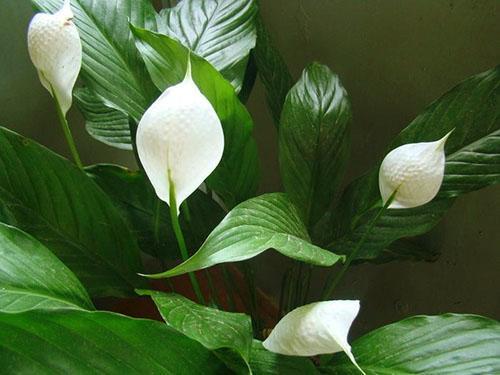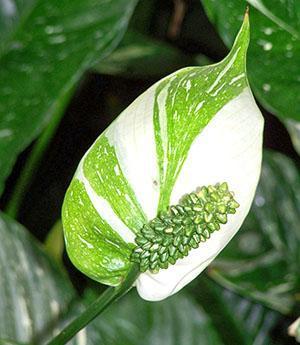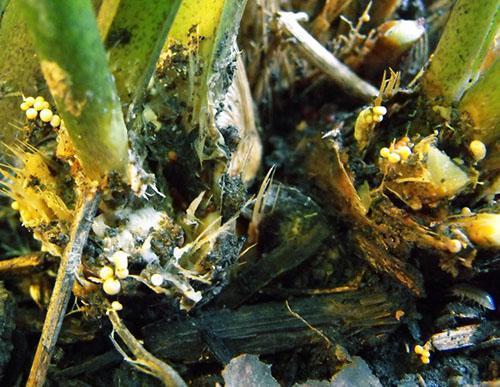Let's find out why spathiphyllum flowers turn green
 In colorful photographs of spathiphyllum and in the description of existing varieties, you can see that the spectacular perianth, thanks to which the plant got its name, has a white or barely creamy color. Imagine the surprise of amateur flower growers when a white blanket, gracefully wrapped around an inflorescence-cob, after a while changes color and turns green.
In colorful photographs of spathiphyllum and in the description of existing varieties, you can see that the spectacular perianth, thanks to which the plant got its name, has a white or barely creamy color. Imagine the surprise of amateur flower growers when a white blanket, gracefully wrapped around an inflorescence-cob, after a while changes color and turns green.
Why do spathiphyllum flowers turn green, and is this not a signal that the plant is experiencing discomfort, lack of nutrients or poor lighting?
Sign of illness or natural development?

In order to attract the attention of insects pollinating a larger number of plants of the Aroid family, a perianth of contrasting color appeared in the process of evolution. As the flowers age and the chance of pollination decreases, the white blanket becomes unnecessary. This is why spathiphyllum flowers turn green. But in order for the plant to release new peduncles as soon as possible, it is better to carefully cut off the old, drying inflorescences.
If a change in the color of the perianth may not bother the grower, then there are symptoms worthy of close attention, as well as taking emergency measures.
Spathiphyllum diseases: photos and descriptions
 Considered an undemanding and easy to grow plant at home, spathiphyllum can still suffer from mishandling and diseases caused by fungi and bacteria.
Considered an undemanding and easy to grow plant at home, spathiphyllum can still suffer from mishandling and diseases caused by fungi and bacteria.
Most often, systemic waterlogging of the soil, lack of light and excessive dryness of the air lead to the weakening of the plant and the development of diseases of the spathiphyllum.
Diseases manifest themselves as:
- yellowing or blackening of foliage;
- refusal of bushes to throw out flower stalks;
- growth arrest;
- even the death of spathiphyllum, if the most drastic measures are not taken in time.
The first traces of spathiphyllum disease become visible on the leaves, which change color and dry out, then the inflorescences turn black and wither, but the main picture is often found underground, where harmful fungi cause devastating damage to the root system, stems and the base of the petioles.
Root rot on spathiphyllum
 Cylindrocladium spathiphylli, or root rot on spathiphyllums, caused by fungi dangerous to the plant, is most common in warm, humid times. The spread is facilitated not only by soil moisture, but also by its low acidity.
Cylindrocladium spathiphylli, or root rot on spathiphyllums, caused by fungi dangerous to the plant, is most common in warm, humid times. The spread is facilitated not only by soil moisture, but also by its low acidity.
Under the influence of spathiphyllum disease, as in the photo, the lower leaves become lethargic and discolored. But these are only obvious symptoms. The main development of the disease occurs under the soil and affects the root system. Reddish-brown spots form on the roots, coinciding with tissue damage.
The affected areas quickly grow, rot away and lose functionality, and thousands of fungal spores remain in the soil, when they get on the leaves and other aerial parts of the plant, rounded brown spots appear, surrounded by yellowed tissue.
Spores are transported by water droplets, so spathiphyllums should not be allowed to be located close to each other or be in contact with water from neighboring pots.Diseased plants are isolated, measures are taken to drain the soil and treated with fungicides. As a preventive measure, they establish watering mode.
 Other harmful fungi, Rhizoctonia solani and Sclerotium rolfsii, which live in the soil, can also cause rotting of the base of the stem, petioles and roots. At the border with the soil, plant tissues are covered with brown spots, which get wet and stratify. On leaf plates and petioles, the spots first have a yellow tint, and then darken and undergo necrosis. Spathiphyllum infected with this disease, especially at a young age, often die and must be removed.
Other harmful fungi, Rhizoctonia solani and Sclerotium rolfsii, which live in the soil, can also cause rotting of the base of the stem, petioles and roots. At the border with the soil, plant tissues are covered with brown spots, which get wet and stratify. On leaf plates and petioles, the spots first have a yellow tint, and then darken and undergo necrosis. Spathiphyllum infected with this disease, especially at a young age, often die and must be removed.
 Having noticed alarming symptoms of root rot, you should not limit yourself to trimming the affected foliage and external inspection of the plant. It is important to make sure that the root system is viable, firm, white, and able to supply the spathiphyllum with moisture and nutrients.
Having noticed alarming symptoms of root rot, you should not limit yourself to trimming the affected foliage and external inspection of the plant. It is important to make sure that the root system is viable, firm, white, and able to supply the spathiphyllum with moisture and nutrients.
- The victims, as in the photo, are removed from the spathiphyllum disease.
- The remaining parts are sprinkled with crushed charcoal.
- Then, the plant treated with the fungicide is transplanted into a new, disinfected soil.
Late blight on the base of the spathiphyllum stem
 The harmful Phytophthora fungus causes root rot and leaf blight. Spores of the causative agent of the disease spathiphyllum are in the soil and, while maintaining high humidity, easily settle on the aerial part of the flower, and also begin to act underground. The first signs of the disease can be seen on the root collar of the plant, which darkens and gets wet.
The harmful Phytophthora fungus causes root rot and leaf blight. Spores of the causative agent of the disease spathiphyllum are in the soil and, while maintaining high humidity, easily settle on the aerial part of the flower, and also begin to act underground. The first signs of the disease can be seen on the root collar of the plant, which darkens and gets wet.
In spathiphyllum plants from the disease, as in the photo, chlorosis of the leaves, their wilting and necrosis develops. The roots, as with other types of rot, soften and die off.
Infection is possible both through tools and through splashes of moisture during watering. To reduce the risk of developing the disease, it is necessary to prevent stagnation of moisture in the pots and to arrange watering so that the top layer of the soil dries up in the intervals.
Sick specimens of spathiphyllum will have to be destroyed, and the remaining plants and related species in the neighborhood must be treated with special preparations.
Chlorosis and edema of spathiphyllumap leaves
 A systematic violation of the conditions for keeping spathiphyllum can result in the development of diseases such as chlorosis of the leaves and their edema.
A systematic violation of the conditions for keeping spathiphyllum can result in the development of diseases such as chlorosis of the leaves and their edema.
The reasons here are:
- high humidity of the air and soil environment, provided that the room temperature is below normal;
- irregular or unbalanced feeding;
- root damage caused by transplant or infection.
The condition when the foliage becomes covered with yellowish-brown convex and constantly growing spots is very painful for spathiphyllum and can lead to the death of the plant.
In order for the bush to regain its former appearance and attractiveness, it is necessary to establish care, including fertilization and watering the flower.
Hommosis of spathiphyllum
 Bacterial leaf wilt caused by Xanthomonas dieffenbachiae and is common not only on spathiphyllums, but also on related plant species, develops at the edges of infected leaves. The leaf plates gradually darken, the tissues dry out and die off. Spathiphyllum disease, as in the photo, can cause serious damage, since, losing foliage, the bush loses some of its strength and nutrition.
Bacterial leaf wilt caused by Xanthomonas dieffenbachiae and is common not only on spathiphyllums, but also on related plant species, develops at the edges of infected leaves. The leaf plates gradually darken, the tissues dry out and die off. Spathiphyllum disease, as in the photo, can cause serious damage, since, losing foliage, the bush loses some of its strength and nutrition.
The pathogen is transferred with water droplets, and the greatest danger to spathiphyllums is when such representatives of the family as dieffenbachia, anthuriums or calla lilies are grown nearby.
Spathiphyllum is affected by a sooty fungus
If plants are attacked by pests, such as aphids, scale insects or mealybugs, the sticky span secreted by insects becomes a site for the development of a sooty fungus. This disease does not cause serious direct harm to spathiphyllum, but the black plaque covering the leaf plates negatively affects the process of photosynthesis, and the plants quickly weaken.
Treatment consists in treating foliage and stalks with soapy water, as well as in treating spathiphyllum with an insecticide that destroys insects.